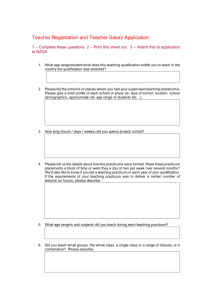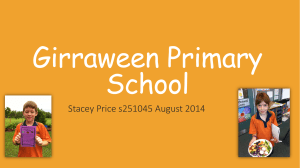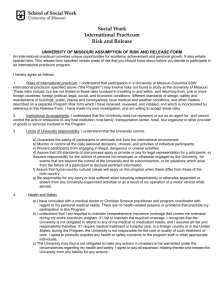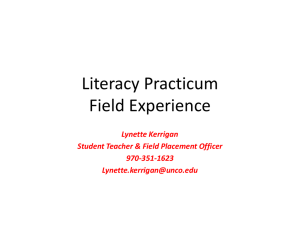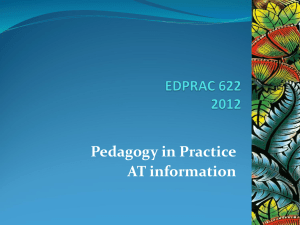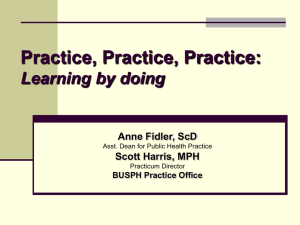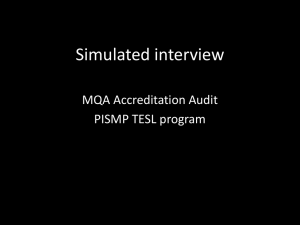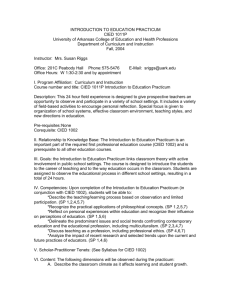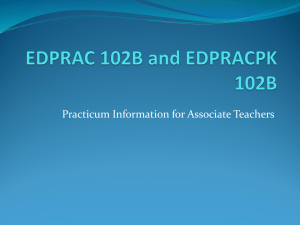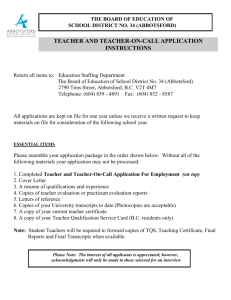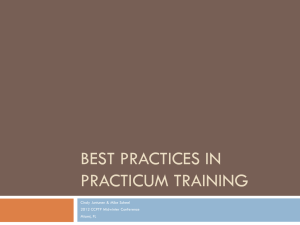EDF 5809 Assessment task 3 - professional e
advertisement
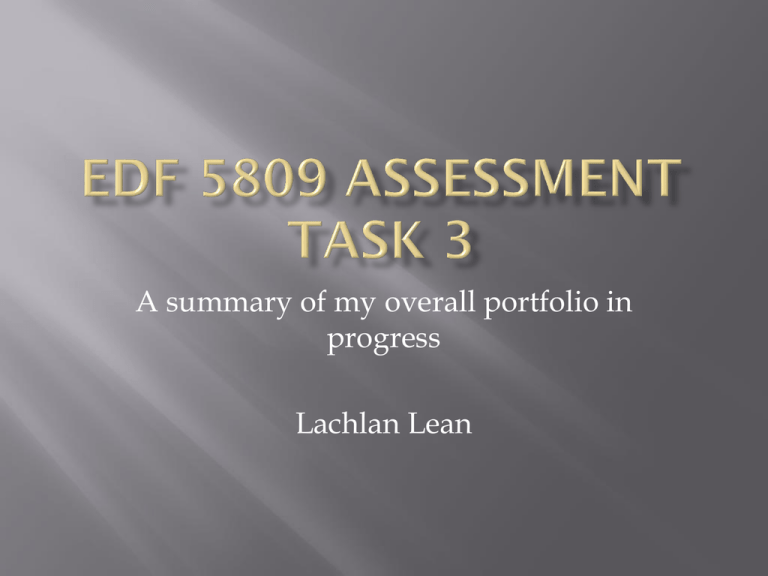
A summary of my overall portfolio in progress Lachlan Lean As part of EDF 5808 - Fostering student engagement in education; we were tasked with researching 10 learner types and providing engagement strategies for each type. In completing this assessment I researched the current theories and explained how I could then use these to create engaging activities for students. This has greatly enhanced my knowledge and understanding in this area; thereby meeting standard 1.3 and 1.5 requirements. 1.3 Demonstrate knowledge of teaching strategies that are responsive to the learning strengths and needs of students from diverse linguistic, cultural, religious and socioeconomic backgrounds. 1.5 Demonstrate knowledge and understanding of strategies for differentiating teaching to meet the specific learning needs of students across the full range of abilities Year 11 Accounting Student Feedback Feedback from both my mentor and students during my first placement reinforced my belief that I had the content knowledge to become a successful teacher. Mary Mackillop Mentor Comments I recognise the importance of using ICT in the classroom and have successfully implemented this during many classes. I am also continually looking for new ways ICT can be incorporated into my classroom to improve my students learning experience. ACCOUNTING UNIT 1 An introduction to Excel for VCE Accounting Unit 1 students Using Excel to prepare cash journals Download the Seoud’s Suit Hire (Excercse 7.14 – Excel template). Save this file into your Excel folder. Open the file. At the bottom of the page are a number of tabs, as shown below: This feature of Excel makes it possible for one file to hold all journals, graphs and reports relating to one business. You will now use functions in Excel to complete the totals. Click on the cell where the total for the Bank column will go. In the top menu bar, click on the Formulas tab, then click on the AutoSum tool. The cell will then look like the following: 2.6 Implement teaching strategies for using ICT to expand curriculum learning opportunities for students “According to research conducted by numerous researchers including Carroll (2011) And Krause, Bochner, Duchesne, and McMaugh (2010), one of the most substantive and pervasive effects of technology on learning is an increase in children’s engagement. Studies conducted by Vardy et al.(2007), Couse and Chen (2010) and Wallace (2008) all showed a significant increase in children’s motivation and engagement with Digital learning tasks”(Carabot 2013) as cited in (Carabot 2014) Throughout my practicum I put together 85 individual lessons plans; with clear lesson aims and student knowledge and skill learning outcomes. In putting these plans together I was constantly referring to theorists such a Bloom to stretch all students. Blooms Taxonomy 3.1 Set learning goals that provide achievable challenges for students of varying abilities and characteristics. Through my studies and practicum I developed engaging Teaching and Learning strategies 3.3 Include a range of teaching strategies. 3.4 Demonstrate knowledge of a range of resources, including ICT, that engage students in their learning. 5. 4. 1. 2. 3. “While we use all of our senses to take in information, we each seem to have preferences in how we learn best. In order to help all students learn, we need to teach to as many of these preferences as possible.” (Cuaresma, 2008) as cited in (Gilakjanji, 2012) page105 Managing challenging behaviour was a challenge for me during practicum. However in modelling teacher as reflector and researcher; I continually sought out new techniques that could be adopted to successfully manage challenging student behaviour. I was very proud to significantly improve in this are as highlighted by my practicum reports. Mary Mackillop Catholic College – 1st Round 4.3 Demonstrate knowledge of practical approaches to manage challenging behaviour. Leongatha SC – 2nd Round I found the Bill Rogers Videos and texts provided significant assistance in helping my behaviour management skills. “The overriding message that I took from Bill Rogers is to recognise explicitly that behaviour is about emotions and associated traits: confidence, self esteem, peer relationships, group acceptance, empathy, belonging, resilience, .. and all the opposites. Crucially, this is for the teacher and the students. There is just no excuse for an angry outburst that has no resolution; for forcing a child into an emotional corner through power or using sarcasm to humiliate. We are the adults. BUT –we are human and we sometimes fail to manage. Sometimes, things go wrong and as teachers we put ourselves on the line emotionally all day. No other job is like that – where you risk being burned by a teenager just because you ask them to do some work. So, Bill Rogers urges us to acknowledge our emotions – and, for me, this helped hugely (Sherrington, 2013).” I agree wholeheartedly with this quote • Assessment of learning (summative) – “gathering evidence of student learning to make judgements about students achievement of objectives, goals and standards.” • Assessment for learning (formative) – “ drawing inferences about student progress from observations and work samples to inform your future teaching”. • Assessment as learning (self reflection) – “requiring students to reflect on and monitor their progress to inform their future learning and your teaching”. (Churchill, 2011) p. 215. During my practicum I continually used a variety of assessment strategies to assess student learning. The information was invaluable in helping modify my teaching approach. (Pham, 2014) Examples of some of my assessments strategies include: Formative Exit Polls Formative Games as quiz’s In putting these assessments Peer Assessment together I was again trying to use Bloom’s Taxonomy to test students abilities across the full spectrum of learning Student Self levels. Reflection Summative Tests 5.1 Demonstrate understanding of assessment strategies, including informal and formal, diagnostic, formative and summative approaches to assess student learning. The Power of Feedback: “To be effective, feedback needs to be clear, purposeful, meaningful, and compatible with student’s prior knowledge and to provide logical connections (Hattie & Timberley, 2007) p. 104. Reports on student achievement 5.2 Demonstrate an understanding of the purpose of providing timely and appropriate feedback to students about their learning. A key learning from my practicum was the importance of using constant and timely feedback allowing students to monitor their own learning. I observed a colleague marking and recording students work almost every afternoon after class. When asked the importance of this he advised “To ensure I know I’m teaching effectively, the students are aware of their learning and I can report to colleagues and parents if and when required”. I attempted to model this behaviour and found it beneficial for my teaching. As a consequence I am confident of demonstrating the graduate standards under this criteria. It is only through discussing and sharing with colleagues and my own continual learning that I will become a better teacher. During placement it was invaluable to receive mentor feedback after each lesson. It allowed me to be aware of areas of my teaching that I could then improve. The tone of my voice was a great example, I was not aware that I was always talking loudly. Therefore I constantly worked on changing my tone during my lessons. This allowed me to better engage with students during class. 6.3 Seek and apply constructive feedback from supervisors and teachers to improve teaching practices. Colleague Feedback During my short journey to becoming a teacher this year I have engaged in professional development both during practicum and through University. I’m also a member of the VCTA (Victorian Commercial Teachers Association) and will be attending their annual conference in November. Therefore I believe I meet both the graduate and proficient levels of this standard. Cybersmart PD PoLT PD 6.2 Understand the relevant and appropriate sources of professional learning for teachers. I believe my 15 years working as a professional has given me the experience and confidence to appropriately deal with people from all levels of an organisation. During practicum both schools graded me an ‘excellent’ in relation to the question “engage professionally, respectfully and ethically with colleagues and other members of the institution”. 7.4 Understand the role of external professionals and community representatives in broadening teachers’ professional knowledge and practice. I have reviewed the VIT professional code of conduct and appreciate the importance of complying with this code. Example of scenario and response 1.4 Teachers maintain objectivity in their relationships with students Social networking sites are the major forum through which teenagers communicate. Is it appropriate for teachers to accept students as ‘friends’, or former students as ‘friends’? I do not believe this would be appropriate, as teachers should maintain professional relationships with the students. 6.2 Understand and apply the key principles described in codes of ethics and conduct for the teaching profession.. As a preservice teacher I believe I maintained these standards however also question how much I was actually tested in this area. Therefore I have reviewed a number of potential scenarios and determined my likely responses. This has prepared me for what may occur during my teaching. Carabot, K. (2014). - Lecture 4 Engaging through popular culture and technology, EDF 5808 Fostering student engagement in Education, Monash University, Clayton, Victoria. Churchill, R. (2011). Teaching: making a difference. Milton, Qld, John Wiley and Sons 1st Edition Gilakjanji, A. P. (2012, February 1). Visual, Auditory, Kinaesthetic Learning Styles and Their Impacts on English Language Teaching. Journal of Studies in Education, 2(1), 104-113. doi:10.5296/jse.v2i1.1007 Hattie, J., Timperley, H. (2007): The power of feedback, Review of Education Research; Mar 2007; 77; 1; p 81-112. DOI: 10.3102/003465430298487 Pham, T. (2014). - Lecture 4 Theory and practice of teaching and learning, EDF 5807 Theory and practice of learning and Teaching, Monash University, Clayton, Victoria. Sherrington, Tom (2013). Behaviour Management: A Bill Rogers Top 10. Retrieved from http://headguruteacher.com/2013/01/06/behaviour-management-a-bill-rogers-top-10/
